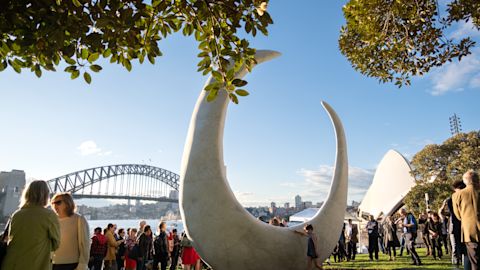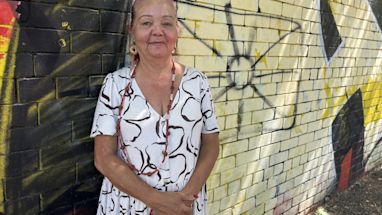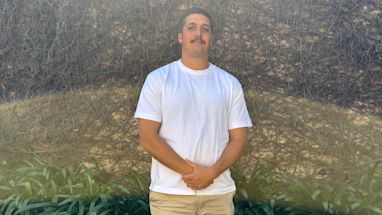Embedded content: https://cityofsydney.wistia.com/medias/nlklhgxiy9
The gleaming 6m high marble monument, inspired by shell fishing hooks handcrafted and used by local Aboriginal women for generations, proudly rests on the lawns overlooking Dubbagullee (Bennelong Point) and Warrane (Circular Quay).
bara, meaning shell hook, by Waanyi artist Judy Watson, honours the Gadigal of the Eora Nation.
Commissioned by the City of Sydney, the project has been guided by the Aboriginal and Torres Strait Islander Advisory Panel, curatorial advisor Hetti Perkins and local Aboriginal community members and organisations.

"The crescent shape is a beautiful expression of Aboriginal technology, with the shells fashioned into fish hooks by women who dangled them from their nawi canoes. The bara is like a reflection of the moon in the sky, the bays in the harbour, the sails of the Sydney Opera House and the Sydney Harbour Bridge," Judy Watson said.
Learn more about bara and hear from its creator and the community
“bara reimagines ancient gathering spaces where people sat by fires on the headlands and feasted. bara will provide a quiet space for ceremony, reflection and contemplation in a busy and ever-changing city. It is inspiring and educational, beautiful and transformative.”

Lord Mayor Clover Moore said the artwork is a reminder and celebration of the enduring contribution of the Eora and First Nations people.
“This stunning artwork is about recognising the destructive impact of invasion on the Gadigal people, honouring Sydney’s first inhabitants and their descendants and promoting respect for the Aboriginal people that make this city what it is today,” the Lord Mayor said.
“This artwork goes someway to answering the clear call from the community for meaningful recognition of Aboriginal and Torres Strait Islander people’s identities and cultures in this city’s public spaces.”

Aunty Bronwyn Penrith, a member of the City of Sydney Aboriginal and Torres Strait Islander Advisory Panel, said referencing fish hooks acknowledges the entrepreneurial role of women in society throughout history.
“The fisherwomen of Sydney fished to feed their families and were also entrepreneurs, trading their catches with other groups around the Sydney basin and beyond,” said Aunty Bronwyn Penrith.
“These fish hooks were a thing of beauty, carved and shiny in the water to attract the fish. Time and care were taken to make the tools of their trade. This embedded the important role of our women in society as providers and sources of sustenance, and providers of industry to our peoples.”

bara is the fourth public art project in the Eora Journey, curated by Hetti Perkins, to honour the heritage and living cultures of Aboriginal and Torres Strait Islander people in the public domain.
“The cultural protocol of welcoming people to Country or acknowledging the traditional custodians of Country is at the heart of this artwork. The artwork exemplifies this symbolic and deeply meaningful public gesture in a tangible and respectful way and is especially important given the national significance of where bara is located,” said curatorial advisor Hetti Perkins.
“bara emerges out of an ancient and enduring Eora cultural context to eloquently express the nexus between the political, social and natural landscapes of historical and contemporary Sydney.”
bara has been supported by the Metropolitan Local Aboriginal Land Council, Tribal Warrior Aboriginal Corporation, The Royal Botanic Garden Sydney, the Australian Museum, the Sydney Opera House and the City of Sydney Aboriginal and Torres Strait Islander Advisory Panel and Public Art Advisory Panel.
Published 30 May 2022, updated 31 May 2022



